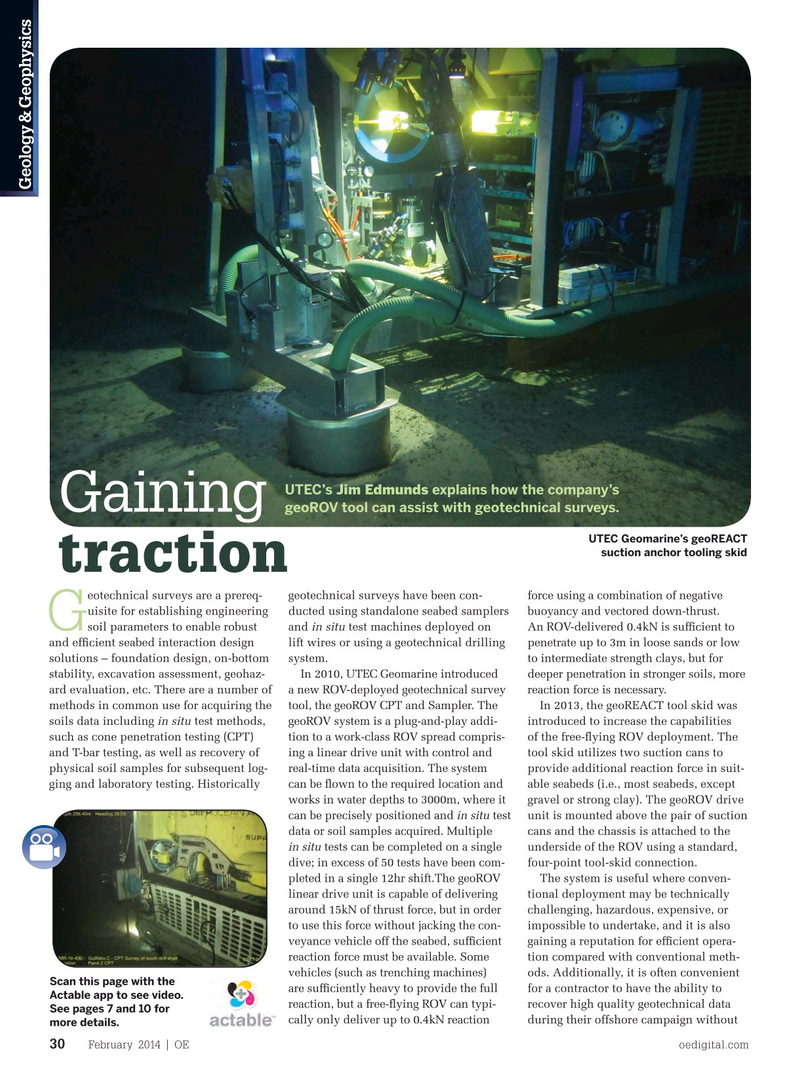
Page 28: of Offshore Engineer Magazine (Feb/Mar 2014)
Read this page in Pdf, Flash or Html5 edition of Feb/Mar 2014 Offshore Engineer Magazine
Geology & Geophysics
UTEC’s Jim Edmunds explains how the company’s
Gaining geoROV tool can assist with geotechnical surveys.
UTEC Geomarine’s geoREACT suction anchor tooling skid t raction eotechnical surveys are a prereq- geotechnical surveys have been con- force using a combination of negative uisite for establishing engineering ducted using standalone seabed samplers buoyancy and vectored down-thrust.
G soil parameters to enable robust and in situ test machines deployed on An ROV-delivered 0.4kN is suf? cient to and ef? cient seabed interaction design lift wires or using a geotechnical drilling penetrate up to 3m in loose sands or low solutions – foundation design, on-bottom system. to intermediate strength clays, but for stability, excavation assessment, geohaz- In 2010, UTEC Geomarine introduced deeper penetration in stronger soils, more ard evaluation, etc. There are a number of a new ROV-deployed geotechnical survey reaction force is necessary. methods in common use for acquiring the tool, the geoROV CPT and Sampler. The In 2013, the geoREACT tool skid was soils data including in situ test methods, geoROV system is a plug-and-play addi- introduced to increase the capabilities such as cone penetration testing (CPT) tion to a work-class ROV spread compris- of the free-? ying ROV deployment. The and T-bar testing, as well as recovery of ing a linear drive unit with control and tool skid utilizes two suction cans to physical soil samples for subsequent log- real-time data acquisition. The system provide additional reaction force in suit- ging and laboratory testing. Historically can be ? own to the required location and able seabeds (i.e., most seabeds, except works in water depths to 3000m, where it gravel or strong clay). The geoROV drive can be precisely positioned and in situ test unit is mounted above the pair of suction data or soil samples acquired. Multiple cans and the chassis is attached to the in situ tests can be completed on a single underside of the ROV using a standard, dive; in excess of 50 tests have been com- four-point tool-skid connection. pleted in a single 12hr shift.The geoROV The system is useful where conven- linear drive unit is capable of delivering tional deployment may be technically around 15kN of thrust force, but in order challenging, hazardous, expensive, or to use this force without jacking the con- impossible to undertake, and it is also veyance vehicle off the seabed, suf? cient gaining a reputation for ef? cient opera- reaction force must be available. Some tion compared with conventional meth- vehicles (such as trenching machines) ods. Additionally, it is often convenient
Scan this page with the are suf? ciently heavy to provide the full for a contractor to have the ability to
Actable app to see video. reaction, but a free-? ying ROV can typi- recover high quality geotechnical data
See pages 7 and 10 for cally only deliver up to 0.4kN reaction during their offshore campaign without more details.
February 2014 | OE oedigital.com 30 030_OE0214_G&G1_UTEC.indd 30 1/21/14 3:39 PM

 27
27

 29
29